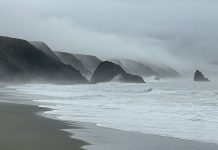Last week’s column mistakenly identified California Spanish moss as Spanish moss. Oops—apologies.
What commonly hangs from trees in Sonoma is lace lichen (Ramalina menziesii), officially designated the state lichen by Gov. Jerry Brown in 2016. Lace lichen, also called fishnet lichen, is mistaken for Spanish moss, but there is no true Spanish moss in California.
Last week, Spanish moss was called out for not being Spanish, nor moss, nor lichen, nor fungi, but a bromeliad related to plants in the pineapple family. This week, lace lichen is called out for not being a plant. Wait, what?
That’s right. Lichens are a strange phenomenon created when fungi and algae cohabitate to form a unique organism. Think of them as combo creatures.
A lichen is formed when organisms from at least two kingdoms combine. As a single living creature, their symbiotic relationship provides the fungi nourishment, while the algae receive structure on which to grow and gather sunlight.
Fungi cannot photosynthesize, and the algae would not survive without their partner. Together, they thrive in the coldest arctic regions to the driest deserts, to the wettest tropical forests.
Fun facts: In North America, there are an estimated 3,600 species of lichen. As a combination creature, their taxonomy is problematic.
Taxonomic classification of living things begins with “kingdoms.” For reference, the hierarchy goes: kingdom, phylum, class, order, family, genus, species.
As recently as the 1970s, textbooks referenced only two kingdoms, plants and animals. However, in a 1969 Science article, ecologist Robert Whittaker introduced the five-kingdom system separating fungi and two other groups thusly: Animalia, Plantae, Fungi, Protista and Monera.
The kingdom Protista includes algae (formerly, plant) and protozoa (formerly, animal), while Monera is composed of bacteria.
Lichens’ greenish color comes from algae, but that color can also come from cyanobacteria known as blue-green algae. To make things confusing, blue-green algae are not algae. They are, of course, Monera—bacteria.
Reversing direction to go up the taxonomic rabbit hole, above kingdom is domain. Domain separates organic (living) from inorganic (non-living).
The question as to how inorganic elements became living creatures is in the process of being solved. This quest for LUCA (Life’s Universal Common Ancestor—the cross-over point from non-living to living), is described in Nick Lane’s scientific page turner, The Vital Question.









